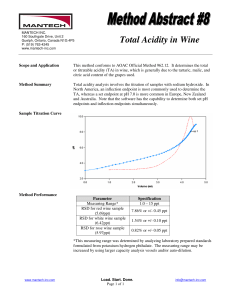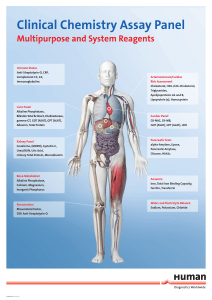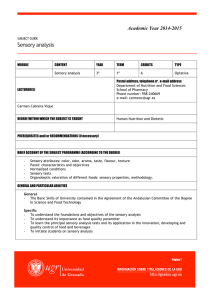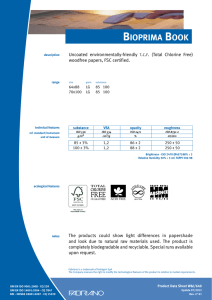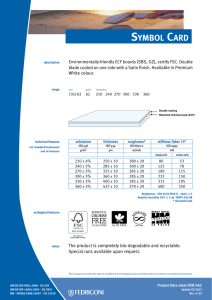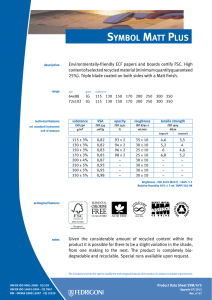Journal of Sensory Studies - 2012 - Torre - Search and Validation of Acidity References in Sensory Evaluation of Pepper
Anuncio
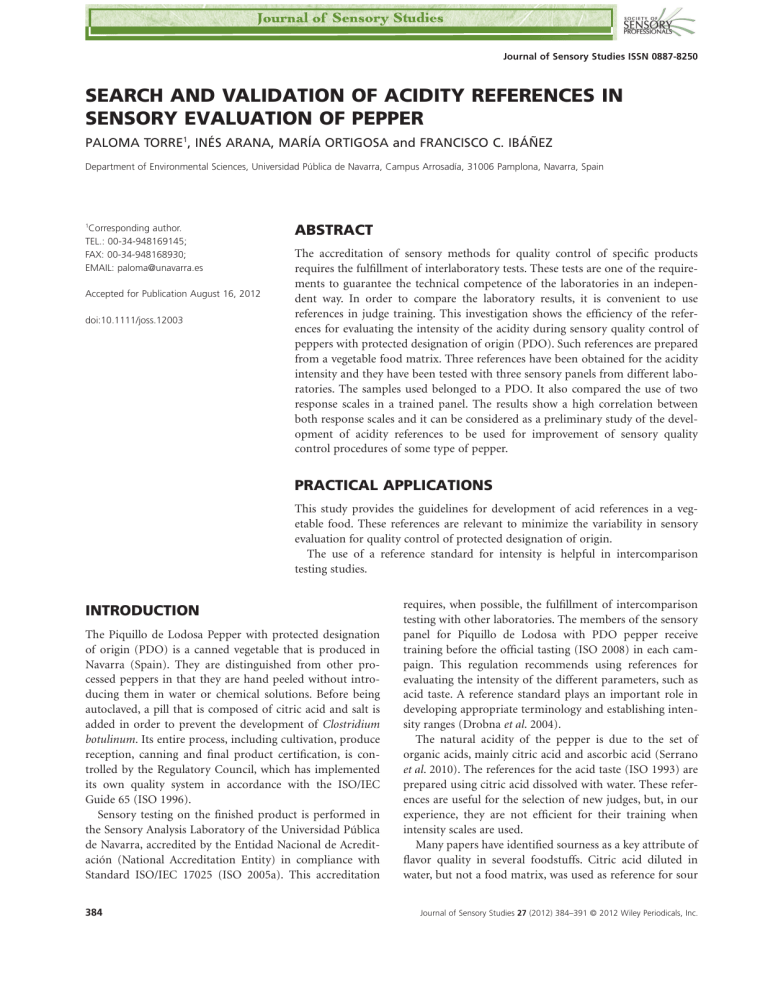
bs_bs_banner Journal of Sensory Studies ISSN 0887-8250 SEARCH AND VALIDATION OF ACIDITY REFERENCES IN SENSORY EVALUATION OF PEPPER PALOMA TORRE1, INÉS ARANA, MARÍA ORTIGOSA and FRANCISCO C. IBÁÑEZ Department of Environmental Sciences, Universidad Pública de Navarra, Campus Arrosadía, 31006 Pamplona, Navarra, Spain 1 Corresponding author. TEL.: 00-34-948169145; FAX: 00-34-948168930; EMAIL: [email protected] Accepted for Publication August 16, 2012 doi:10.1111/joss.12003 ABSTRACT The accreditation of sensory methods for quality control of specific products requires the fulfillment of interlaboratory tests. These tests are one of the requirements to guarantee the technical competence of the laboratories in an independent way. In order to compare the laboratory results, it is convenient to use references in judge training. This investigation shows the efficiency of the references for evaluating the intensity of the acidity during sensory quality control of peppers with protected designation of origin (PDO). Such references are prepared from a vegetable food matrix. Three references have been obtained for the acidity intensity and they have been tested with three sensory panels from different laboratories. The samples used belonged to a PDO. It also compared the use of two response scales in a trained panel. The results show a high correlation between both response scales and it can be considered as a preliminary study of the development of acidity references to be used for improvement of sensory quality control procedures of some type of pepper. PRACTICAL APPLICATIONS This study provides the guidelines for development of acid references in a vegetable food. These references are relevant to minimize the variability in sensory evaluation for quality control of protected designation of origin. The use of a reference standard for intensity is helpful in intercomparison testing studies. INTRODUCTION The Piquillo de Lodosa Pepper with protected designation of origin (PDO) is a canned vegetable that is produced in Navarra (Spain). They are distinguished from other processed peppers in that they are hand peeled without introducing them in water or chemical solutions. Before being autoclaved, a pill that is composed of citric acid and salt is added in order to prevent the development of Clostridium botulinum. Its entire process, including cultivation, produce reception, canning and final product certification, is controlled by the Regulatory Council, which has implemented its own quality system in accordance with the ISO/IEC Guide 65 (ISO 1996). Sensory testing on the finished product is performed in the Sensory Analysis Laboratory of the Universidad Pública de Navarra, accredited by the Entidad Nacional de Acreditación (National Accreditation Entity) in compliance with Standard ISO/IEC 17025 (ISO 2005a). This accreditation 384 requires, when possible, the fulfillment of intercomparison testing with other laboratories. The members of the sensory panel for Piquillo de Lodosa with PDO pepper receive training before the official tasting (ISO 2008) in each campaign. This regulation recommends using references for evaluating the intensity of the different parameters, such as acid taste. A reference standard plays an important role in developing appropriate terminology and establishing intensity ranges (Drobna et al. 2004). The natural acidity of the pepper is due to the set of organic acids, mainly citric acid and ascorbic acid (Serrano et al. 2010). The references for the acid taste (ISO 1993) are prepared using citric acid dissolved with water. These references are useful for the selection of new judges, but, in our experience, they are not efficient for their training when intensity scales are used. Many papers have identified sourness as a key attribute of flavor quality in several foodstuffs. Citric acid diluted in water, but not a food matrix, was used as reference for sour Journal of Sensory Studies 27 (2012) 384–391 © 2012 Wiley Periodicals, Inc. P. TORRE ET AL. taste. For example, in fresh and processed tomatoes (Baldwin et al. 2008; Hongsoongnern and Chambers 2008), pomegranate juice (Koppel and Chambers 2010), wholegrain rice (Bett-Garber et al. 2012), sweet potato cultivars (Leksrisompong et al. 2012), strawberry jam (Koppel et al. 2011), and fresh leafy vegetables (Talavera-Bianchi et al. 2010). However, different emulsions were developed to evaluate the near-threshold taste intensities of sourness. These emulsions were formulated with different lipid chemical compositions plus citric acid addition (Thurgood and Martini 2010). Our objective was to obtain the sensation desired in that reference that is the closest possible to the perception of that sensation in the food itself. Some references prepared on a similar matrix to the food are being evaluated in other studies. For instance, in order to evaluate the acidity in cheese, a milk product made with yoghurt combined with curd is used as reference (Pérez-Elortondo et al. 2007). However, in the analysis of peppers there are no adequate references for the training of judges or for performing sensory analysis intercomparison tests between laboratories. Contextual shifting in the use of rating scales is a potential problem for sensory evaluations. It is even more problematic when the data from different sessions are to be compared (Diamond and Lawless 2001). For this reason, in the present study, we have developed some acid references on a matrix food similar to the pepper itself. In preliminary tests, the intention was to prepare references with acidified peppers by keeping the samples several hours in their own covering liquid enriched with citric acid, but the acid intensity achieved in the pepper samples turned out to be heterogeneous. So it was decided to prepare references with pepper purée and added citric acid for the purpose of properly homogenizing the acidity. In sensory analysis, the perception of a property, not the property itself, is evaluated, and different types of measurement scales can be used (ordinal, interval, proportion) as well as different models of response scales. The response scale (i.e., numerical, verbal or graphic), is the tool the judge uses to register the quantitative response. Thus, a scale of continuous response (linear) gives the judges the opportunity to express minor differences in their judgments, but it may result as harder to use than a numerical scale of categories (ISO 2003). On the other hand, it is hard to maintain the equality of the intervals proposed in an interval scale with numerical category response. The judges with low training consider that a 9-point category scale is easier to use than the continuous 15 cm scale (Lawless and Malone 1986), but the smaller the number of categories the higher is the effect of the extremes, which lessens the discriminatory power of the scale (Park et al. 2004, 2007). For the purpose of comparing the use of both types of response scales in a trained panel, in this study the tasters have used a Journal of Sensory Studies 27 (2012) 384–391 © 2012 Wiley Periodicals, Inc. ACIDITY REFERENCES IN PEPPER 6-category numerical scale as well as a continuous 10 cm scale simultaneously (ISO 2003). In both cases, point zero (absence of acidity) was located at one end of the scale (unipolar scale). The main objective of this study has been to develop some valid acidity references for the purpose of improving the results of a sensory panel that has been trained in sensory analysis of the acidity in Piquillo de Lodosa peppers with PDO and to verify its usefulness in other less trained panels. A secondary objective has been to compare the use of two response scales in a trained panel. MATERIAL AND METHODS Three consecutive tests were conducted: • Preliminary selection of references: Six tasting sessions were held and in each session three acidity references with different concentrations of citric acid were evaluated, in order to associate them to the intensity scores of the sensory scale. This test is also useful to measure the acidity intensity of roasted natural PDO pepper and the acidity provided by adding the pill in its processing. • Final selection of references for the acidity intensity: Two new acidity references associated to the high and midpoint of the sensory scale were selected and the intensities assigned were compared three times by means of a numerical scale of categories and a continuous scale (ISO 2003). • Verification of the efficiency of the acidity references: An intercomparative test was carried out so as to verify the efficiency of the above-mentioned references developed, using three tasting panels from three different sensory analysis laboratories (1, 2 and 3) with different degrees of training. Initial Selection of References Preparation of References. Pepper natural acidity, expressed as citric acid, is approximately 0.33% (w/w) (Serrano et al. 2010). But it may range between 0.19 and 0.61% (w/w) fresh weight depending on the different genotypes (Eggink et al. 2012). In this study, acidity was considered as a constant for all the samples, and for practical purposes, it was established as 0.0% (w/w), namely without acid citric added. This natural acidity of the peppers has not been taken into account when calculating the final concentrations in the references. Most of the production of Piquillo peppers is canned. During its processing, a pill of Diapim containing 16% citric acid and 84% salt is added in each can. For an accurate sensory evaluation, it is necessary to find a reference standard that is low in secondary tastes. An expert judge with a qualification of over 10 years for the sensory analysis of Piquillo de Lodosa PDO peppers always 385 ACIDITY REFERENCES IN PEPPER tasted the samples of PDO peppers and eliminated the ones that had more acidity than normal, as well as those that were hot/spicy, so as to eliminate possible interferences. Any remaining seeds and burnt peel had been removed from the peppers and then they were crushed. Paste with 0.0% (w/w) Citric Acid. From the selected samples, a homogeneous paste was made with Piquillo de Lodosa PDO peppers that were roasted but not canned. These peppers were purchased on the market at the time when they are in season. The peppers were made into a puree with a homogeneous texture using a blender. Paste with 0.12% (w/w) Citric Acid. Purée was made with canned Piquillo de Lodosa PDO peppers. Pastes between 0.17 and 0.23% (w/w) Citric Acid. They were obtained by weighing 225 g of the canned pepper paste above and adding the quantity of citric acid necessary to reach the corresponding final concentration. Citric acid was previously solubilized in 45 mL of deionized water. Sensory Panel. The panel was composed of 14 expert sensory assessors belonging to the sensory panel of Piquillo de Lodosa PDO pepper. This panel was first selected according to the guidelines of the standard (ISO 1993) and it has a periodic control and performance evaluation in compliance with standard ISO 8586-2 (ISO 2008). Procedure. The study was performed in tasting booths with properly controlled environment conditions (ISO 2007). Six tasting sessions on different days were held in which the references were presented to the tasters in plastic cups labeled with a three-digit code in random order. They were tasted at room temperature. Tasters were instructed to take a comfortable amount of the sample into their mouth and swish it around for approximately 5 s. The evaluation of the acidity intensity of the pepper pastes was requested by means of a 6-category numerical response scale (0: absence, 1: very weak, 2: weak, 3: medium, 4: intense and 5: very intense) (ISO 2003). The tasters had available water and unsalted breadsticks as palate cleansers between references. The tasters were allowed to taste the references again and review and change their scores, for it has been proven that this reduces discriminative errors (Lee et al. 2001; Jeon et al. 2004). Statistics. A model of one-way analysis of variance (ANOVA) on the data of acidity concentration was performed. Afterwards, multiple post hoc comparisons were done by means of the Bonferroni test. All of the analyses were done with the help of the statistical package SPSS v.18 (Windows version, SPSS, Inc., Chicago, IL). 386 P. TORRE ET AL. Final Selection of References Preparation of References. New references were made with a food matrix of pepper, using the same methodology as in the section “Initial Selection of References.” In order to achieve references with greater acidity intensities, pepper pastes were prepared with Piquillo PDO peppers canned with a concentration of 0.12, 0.5 and 1% citric acid, the latter two adding the grams of citric acid necessary to reach the corresponding concentration. Sensory Panel. The panel was composed of the same 14 expert sensory assessors of the tasting panel of Piquillo de Lodosa PDO peppers. Procedure. Each assessor tasted the same three references in three consecutive sessions. The sessions were conducted in 1 day, with 10-min breaks between replicates to reduce sensory fatigue. In each session, the three concentrations (0.12, 0.5 and 1% [w/w] citric acid) were tasted in random order in three-digit coded cups. The assessors were instructed to wait for 1 min between samples. In each session, the intensity of the acidity of the pepper pastes was evaluated simultaneously through the use of two types of response scales: the numerical scale of categories and a continuous 10 cm line unstructured scale (ISO 2003) with anchors in the extremes: not acid and very acid. The position marked by the assessors on this scale was converted to a number between 0 and 100. Statistics. With the data of acidity concentration, one-way ANOVA was used and afterwards multiple post hoc comparisons were done by means of the Bonferroni test. A box plot was made as well. A regression analysis was performed on the acidity intensities obtained through the two types of response scales used (numerical of categories and continuous) in order to study the correlation between them. All of the analyses were done with the statistical package SPSS v.18 (Windows version, SPSS, Inc.). Verification of the Utility of the References Preparation of References. The three confirmed references from previous section for categories – 2: weak acidity, 3: medium acidity and 5: very intense acidity – were prepared in Laboratory 1 and were transported refrigerated to Laboratories 2 and 3. A person from Laboratory 1 moved to Laboratories 2 and 3 to do this test. Samples. Three different samples from different peppers, two samples Piquillo de Lodosa PDO peppers (coded as A and C) and another sample of Piquillo peppers without Journal of Sensory Studies 27 (2012) 384–391 © 2012 Wiley Periodicals, Inc. P. TORRE ET AL. ACIDITY REFERENCES IN PEPPER PDO (coded as B), were used. For this purpose, three cans of the same production batch for each sample were acquired and distributed to the three laboratories. Although the samples of each panel came from cans of the same lot, certain variability between samples is common. In order to reduce such variability, a pepper was carefully cut in equal pieces for all the tasters of the same panel, so that all the panelists tasted a portion of the same pepper, with or without references. Sensory Panel. Three laboratories with sensory panels with different degrees of training took part in this study. The first panel was from the Universidad Pública de Navarra (Laboratory 1), with seven expert sensory assessors of Piquillo de Lodosa PDO peppers. Laboratory 2, with eight tasters, is in charge of quality control board of Roasted IGP peppers from el Bierzo (León, Spain). Laboratory 3 was composed of nine tasters trained in the laboratory of the Instituto Tecnológico Agrario de Castilla y León (Valladolid, Spain). Hereinafter, these panels will be referred to as 1, 2 and 3. Panel 1 is the most highly trained in the evaluation of Piquillo de Lodosa PDO pepper. Panel 3 is very experienced in the sensory analysis of a great variety of vegetable samples, and Panel 2 is the one with the lowest degree of training. Procedure. The sessions were held in the tasting rooms of each laboratory. In each laboratory, two sessions were held. In the first session, each panelist was presented three portions in random order according to a random pattern of distribution of the samples (ISO 2005b). The acidity was evaluated by means of the 6-category numerical scale. The tasters had to evaluate the acidity of the three pepper samples without the help of references. Tasters chewed the sample in order to evaluate its acid intensity. They waited for 2 min before tasting each portion. In the second session, after a 5-min break, they tasted the weak, medium and very intense acid references. The references were distributed in small cups with a spoon. The cups were coded with the numbers 2, 3 and 5 depending on the acid intensity of the reference. Next, each taster was given, in the same order as in the first presentation, portions of the same peppers so that they could rate the acidity again. The tasters were allowed to taste the references again. Statistics. In addition to the descriptive statistics of the data, box plots were done. For the inferential analysis, a TABLE 1. AVERAGE VALUES AND STANDARD DEVIATIONS IN THE INTENSITY OF THE ACID TASTE IN THE PEPPER PASTE REFERENCES PREPARED WITH NATURAL ROASTED PEPPER (NP); ROASTED, CANNED PEPPER (CP) AND CP PLUS CITRIC ACID (CPC). (N = 14 TASTERS) three-factor ANOVA was used (panel, sample and references), including the interaction terms of three and two factors. Likewise, the acidity intensities were compared in accordance with whether or not references were used. The differences between the intensities were analyzed by means of a Student’s t-test for depending samples. The contrast in the hypotheses in all of the tests was done through a bilateral test establishing the significance level at 5%. All of the analyses were done with the help of the statistical package SPSS v.18 (Windows version, SPSS, Inc.). RESULTS AND DISCUSSION Initial Selection of References The paste of the natural roasted, not canned pepper (NP), was perceived by the tasters with a very weak acidity intensity, a 1 on the scale (Table 1). The tasters classified the paste from canned PDO peppers (CPs) whose citric acid concentration was 0.12% (w/w) around the category of weak acidity, a 2 on the scale. Initially, the hypothesis suggested was that in doubling the initial concentration (0.23% [w/w]), a reference around 5 (very intense) would be achieved. For this reason, the references prepared had a citric acid concentration of 0.17, 0.20 and 0.23% (w/w) citric acid, in the attempt to achieve acidity intensities that were medium, intense and very intense. However, the results (Table 1) showed that although the average values are slightly higher, there were no important differences in acidity between the three concentrations tested and the 0.12% (w/w) citric acid concentration. It is important to note that a reference standard establishes relative rather than absolute intensity. Final Selection of References The result of the tests performed with citric acid concentrations of 0.12, 0.5 and 1% (w/w) citric acid is shown on Table 2. The concentrations 0.5% (w/w) citric acid (medium acidity) and 1% (w/w) citric acid (very intense acidity) were used as references for the category numerical and the continuous scales. It is confirmed that the CP paste serves as reference for the category of weak intensity. Figure 1 shows the box plots of the three sessions held. There is lower variability in the results of the first session, Sample NP CP CPC-1 CPC-2 CPC-3 Citric acid % Acidity intensity 0.00 0.9 ⫾ 1.0a 0.12 2.0 ⫾ 0.8b 0.17 2.2 ⫾ 1.0b 0.20 2.3 ⫾ 1.1b 0.23 2.4 ⫾ 1.1b *** *** P < 0.001. Different letters in the same row indicate significant differences between the average values. Journal of Sensory Studies 27 (2012) 384–391 © 2012 Wiley Periodicals, Inc. 387 ACIDITY REFERENCES IN PEPPER P. TORRE ET AL. Citric acid % 0.12 0.50 1.00 P Acidity intensity (EE) Acidity intensity (EC) (mm) 1.9 ⫾ 1.0a 29.6 ⫾ 19.6a 3.1 ⫾ 1.1b 56.3 ⫾ 25.5b 4.6 ⫾ 0.7c 88.4 ⫾ 15.3c *** *** *** P < 0.001. EE: 6-category numerical scale: 0: absence, 1: very weak, 2: weak, 3: medium, 4: intense and 5: very intense. EC: 100 mm continuous line unstructured scale (with anchors from not acid to very acid). Different letters in the same row indicate significant differences between the average values. which could indicate sensory fatigue of the tasters in the next sessions: It is known that citric acid produces selfdesensitization caused by repeated stimulation (Dessirier et al. 2000). Nevertheless, the same average values were obtained in the three sessions, which confirms the consistency of data provided by the panel. In the second test, a regression analysis of the acid intensities obtained by both types of scales, continuous and numerical categories, was performed. The result (Fig. 2) evidences that there is a high correlation (R2 = 0.922). According to Stevens (1969), the relation between both types of scales must be linear as occurs in this case. It must be pointed out that some assessors assigned intensities 0, with the numerical category scale evaluating samples with 0.12% citric acid in the second and third sessions. On the other hand, the use of the continuous scale enabled higher scores when estimating the intensity of the highest concentration. The linear relation between the citric acid concentration and the estimation of the intensity is a little better with the numerical category scale. Perhaps this could be attributed to the fact that the tasters are more familiar with this scale. This result indicates that the quality of the measurements TABLE 2. AVERAGE VALUES AND STANDARD DEVIATIONS OF THE SCORES GIVEN FOR THE ACID INTENSITIES IN THE REFERENCES OF PASTE OF CANNED PEPPER WITH ADDED CITRIC ACID (N = 14 TASTERS AND THREE REPEATED SAMPLES FOR EACH CONCENTRATION) depends on the manner in which they have been obtained, for example on the level of training of the judges (ISO 2003). It is important to note that in order for the acidity references to be as uniform as possible throughout the successive training campaigns, it is recommended to always use peppers belonging to PDO and of the same brand as the one used in this study. Verification of the Usefulness of the References The results of the scores assigned to the three samples by juries 1, 2 and 3 are summarized in Table 3. The interaction term of the three factors in the ANOVA was not statistically significant (P = 0.197). Therefore, there is no combined effect of these factors. However, one interaction term of two factors was statistically significant (P = 0.03), in particular the combined effect “laboratory ¥ sample.” It can be deduced that the evaluation of the acidity can be conditioned by a “psychological emotional” component in relation with the type of pepper each panelist is accustomed to analyzing. Session 1 Session 2 Session 3 Acidity intensity 5 4 3 2 1 Acidity intensity (continuous scale) 100 80 60 40 20 0 0.12 0.50 1.00 0.12 0.50 1.00 Citric acid (%) 0.12 0.50 1.00 0 0 1 2 3 4 5 Acidity intensity (structured scale) FIG. 1. BOX PLOT OF THE ACIDITY INTENSITIES OBTAINED BY PANEL 1 WITH THE NUMERICAL SCALE OF CATEGORIES IN THREE SESSIONS WITH THREE CITRIC ACID CONCENTRATIONS Data are expressed as percentage of citric acid (n = 14 Tasters). 388 FIG. 2. CORRELATION OF THE ACID INTENSITIES OBTAINED BY MEANS OF THE CONTINUOUS AND NUMERICAL CATEGORY SCALES (N = 14) Journal of Sensory Studies 27 (2012) 384–391 © 2012 Wiley Periodicals, Inc. P. TORRE ET AL. ACIDITY REFERENCES IN PEPPER TABLE 3. AVERAGE VALUES OF THE ACIDITY SCORES AND THEIR STANDARD DEVIATIONS FOR THE SAMPLES OF PEPPER A (PDO), B (NOT PDO) AND C (PDO), EVALUATED WITHOUT AND WITH REFERENCES IN THE PANELS 1 (N = 7), 2 (N = 8) AND 3 (N = 9) Sample Panel Without references With references P A 1 2 3 1 2 3 1 2 3 2.1 ⫾ 1.1 2.5 ⫾ 1.4 2.1 ⫾ 0.9 1.1 ⫾ 0.9 2.4 ⫾ 0.9 0.9 ⫾ 0.8 1.9 ⫾ 0.9 3.4 ⫾ 0.7 2.6 ⫾ 1.0 1.7 ⫾ 0.5 2.8 ⫾ 0.7 2.6 ⫾ 0.9 0.7 ⫾ 0.5 1.8 ⫾ 0.7 1.2 ⫾ 1.0 2.0 ⫾ 0.6 4.6 ⫾ 0.5 2.7 ⫾ 1.4 NS NS * NS * NS NS * NS B C * P < 0.05. NS, not significant. Comparing the scores given for the acid intensity in each sample (A, B and C) within each of the sensory panels and depending on whether or not the references were used (Table 3), the following can be seen: • In Panel 1, the acid taste intensity score does not change significantly after the use of references. • In Panel 2 (the one with the lowest degree of training), the score of the acid taste intensity changed significantly in samples B where the score was reduced, getting closer to the score given by other juries. However, the case of sample C increased unexpectedly. PANEL 1 • In Panel 3, the acid taste intensity score does not change significantly after the use of references except for sample A, which slightly increases its score. As can be seen in Fig. 3, in the case of Panel 1, there is a reduction of dispersion in the scores of the three samples after using the acid references. Panel 2 has also reduced the dispersion in the scores after using the acidity references, although perhaps not as sharply as Panel 1. Panel 2 (the one with the lowest degree of training) is the one registering the highest variability in the scores. In the case of Panel 3, after using the acid references, it increased its dispersion in the scores for samples A and B, but decreased the variability in evaluating sample C. The results obtained differ for each panel. In the case of Panel 1, the average score does not vary between before and after the use of references; however, the dispersion is reduced after using the references. This panel had already worked and been trained with these references. Regarding the other two sensory panels, Panel 2 corrected its acidity score after using the references with sample B, so it seems that the use of references improved its response; the Piquillo without PDO peppers hardly had acidity. However, with sample C, it started with a high acidity intensity and after tasting the references, it has increased acidity. Possibly, there was an interference from some other taste not discriminated by the panel; e.g., that the sample was slightly hot/spicy, for it is known that citric acid has sensory properties similar to those exhibited by capsaicin (sensitization at short intervals, self- and cross-desensitization) (Dessirier et al. 2000). Nevertheless, after the use of references, the PANEL 2 PANEL 3 5 Acidity intensity 4 3 2 1 0 sample A sample B sample C sample A sample B sample C sample A sample B sample C FIG. 3. COMPARISON OF THE AVERAGE VALUES AND DISPERSIONS OF THE SCORES FOR ACIDITY INTENSITY WITHOUT (䊐) AND WITH (䊏) THE USE OF REFERENCES IN THE THREE PANELS Journal of Sensory Studies 27 (2012) 384–391 © 2012 Wiley Periodicals, Inc. 389 ACIDITY REFERENCES IN PEPPER dispersion of intensities attributed to this sample is reduced. Panel 3 only changed the score of sample A after tasting the references and, in this case, its scores are somewhat higher. In this panel, contrary to what was expected, the use of references did not contribute to control data dispersion, and instead it increased. CONCLUSIONS • The measurement of the acidity of Piquillo de Lodosa PDO pepper pastes using an interval measurement scale with a six-category numerical response scale (0: absence, 1: very weak, 2: weak, 3: medium, 4: intense and 5: very intense) gives the following values: NP Piquillo de Lodosa PDO pepper paste intensity 1, very weak, attributable to its own natural acidity; Roasted, canned Piquillo de Lodosa PDO pepper paste: intensity 2, weak, due to the combination of pepper’s own acidity and the acidity from the pill added during elaboration. The addition of citric acid up to concentrations between 0.17 and 0.23% (considering 0.0% citric acid as natural acidity) does not manage to increase significantly the perception of acidity intensity. It is necessary to reach concentrations between 0.5 and 1% citric acid in order for the perception to increase up to medium and very intense acidity, respectively. These references are appropriate for categories 3 and 5 of the scale. • In a trained panel, both the numerical scale of categories and the continuous scale are equally valid for correctly evaluating the acidity intensity. • The use of references of acid taste, prepared on a paste of the same food matrix that the tasting panel uses normally, reduces the dispersion in the acid intensity scores and therefore is useful for the training and formation of tasters. These references have proven valid for the pimiento Piquillo PDO panel. The results are not conclusive when these acid taste references are used for the first time, with panels that are used to different food. It should be confirmed with new tests whether the use of acidity references, whose basis is other than the product that is usually evaluated by a panel, has an influence on the assignment of the acid intensity. The use of panels that are not familiarized with the product to validate references may be successful, but we think it would require prior training sessions with the references in order to evaluate their validity. ACKNOWLEDGMENTS All judges from three sensory panels are thanked for their participation. REFERENCES BALDWIN, E.A., GOODNER, K. and PLOTTO, A. 2008. Interaction of volatiles, sugars, and acids on perception of 390 P. TORRE ET AL. tomato aroma and flavor descriptors. J. Food Sci. 73, 294–307. BETT-GARBER, K.L., LEA, J.M., CHAMPAGNE, E.T. and MCCLUNG, A.M. 2012. Whole-grain rice flavor associated with assorted bran colors. J. Sensory Studies 27, 78–86. DESSIRIER, J.M., O’MAHONY, M., IODI-CARSTENS, M. and CARSTENS, E. 2000. Sensory properties of citric acid: Psychophysical evidence for sensitization, self-desensitization, cross-desensitization and cross-stimulus-induced recovery following capsaicin. Chem. Senses 25, 769–780. DIAMOND, J. and LAWLESS, H.T. 2001. Context effects and reference standards with magnitude estimation and the labeled magnitude scale. J. Sensory Studies 16, 1–10. DROBNA, Z., WISMER, W.V. and GOONEWARDENE, L.A. 2004. Selection of an astringency reference standard for the sensory evaluation of black tea. J. Sensory Studies 19, 119–132. EGGINK, P.M., MALIEPAARD, C., TIKUNOV, Y., HAANSTRA, J.P.W., BOVY, A.G. and VISSER, R.G.F. 2012. A taste of sweet pepper: Volatile and non-volatile chemical composition of fresh sweet pepper (Capsicum annuum) in relation to sensory evaluation of taste. Food Chem. 132, 301–310. HONGSOONGNERN, P. and CHAMBERS, E.I.V. 2008. A lexicon for texture and flavor characteristics of fresh and processed tomatoes. J. Sensory Studies 23, 583–599. ISO. 1993. Sensory analysis – general guidance for the selection, training and monitoring of assessors – part 1: Selected assessors. ISO 8586-1.1993. International Organization for Standardization, Geneva, Switzerland. ISO. 1996. General requirements for bodies operating product certification systems. ISO/IEC Guide 65.1996. International Organization for Standardization, Geneva, Switzerland. ISO. 2003. Sensory analysis – guidelines for the use of quantitative response scales. ISO 4121. 2003. International Organization for Standardization, Geneva, Switzerland. ISO. 2005a. General requirements for the competence of testing and calibration laboratories. ISO/IEC 17025.2005. International Organization for Standardization, Geneva, Switzerland. ISO. 2005b. Sensory analysis – methodology – general guidance. ISO 6658.2005. International Organization for Standardization, Geneva, Switzerland. ISO. 2007. Sensory analysis – general guidance for the design of test rooms. ISO 8589. 2007. International Organization for Standardization, Geneva, Switzerland. ISO. 2008. Sensory analysis – general guidance for the selection, training and monitoring of assessors – part 2: Expert sensory assessors. ISO 8586-2.2008. International Organization for Standardization, Geneva, Switzerland. JEON, S.Y., O’MAHONY, M. and KIM, K.O. 2004. A comparison of category and line scales under various experimental protocols. J. Sensory Studies 19, 49–66. KOPPEL, K. and CHAMBERS, E.I.V. 2010. Development and application of a lexicon to describe the flavor of pomegranate juice. J. Sensory Studies 25, 819–837. Journal of Sensory Studies 27 (2012) 384–391 © 2012 Wiley Periodicals, Inc. P. TORRE ET AL. KOPPEL, K., TIMBERG, L., SALUMETS, A. and PAALME, T. 2011. Possibility for a strawberry jam sensory standard. J. Sensory Studies 26, 71–80. LAWLESS, A. and MALONE, G.J. 1986. The discriminative efficiency of common scaling methods. J. Sensory Studies 1, 85–98. LEE, H.J., KIM, K.O. and O’MAHONY, M. 2001. Effects of forgetting on various protocols for category and line scales of intensity. J. Sensory Studies 16, 327–342. LEKSRISOMPONG, P.P., WHITSON, M.E., TRUONG, V.D. and DRAKE, M.A. 2012. Sensory attributes and consumer acceptance of sweet potato cultivars with varying flesh colors. J. Sensory Studies 27, 59–69. PARK, J.Y., JEON, S.Y., O’MAHONY, M. and KIM, K.O. 2004. Induction of scaling errors. J. Sensory Studies 19, 261–271. PARK, J.Y., O’MAHONY, M. and KIM, K.O. 2007. “Different-stimulus” scalingerrors; effects of scalelength. Food Qual. Prefer. 18, 362–368. Journal of Sensory Studies 27 (2012) 384–391 © 2012 Wiley Periodicals, Inc. ACIDITY REFERENCES IN PEPPER PÉREZ-ELORTONDO, F., OJEDA, M., ALBISU, M., SALMERÓN, J., ETAYO, I. and MOLINA, M. 2007. Food quality certification: An approach for the development of accredited sensory evaluation methods. Food Qual. Prefer. 18, 425–439. SERRANO, M., ZAPATA, P.J., CASTILLO, S., GUILLÉN, F., MARTÍNEZ-ROMERO, D. and VALERO, D. 2010. Antioxidant and nutritive constituents during sweet pepper development and ripening are enhanced by nitrophenolate treatments. Food Chem. 118, 497–503. STEVENS, S. 1969. Sensory scales of taste intensity. Atten. Percept. Psychophys. 6, 302–308. TALAVERA-BIANCHI, M., CHAMBERS, E.I.V. and CHAMBERS, D.H. 2010. Lexicon to describe flavor of fresh leafy vegetables. J. Sensory Studies 25, 163–183. THURGOOD, J.E. and MARTINI, S. 2010. Effects of three emulsion compositions on taste thresholds and intensity ratings of five taste compounds. J. Sensory Studies 25, 861–875. 391
